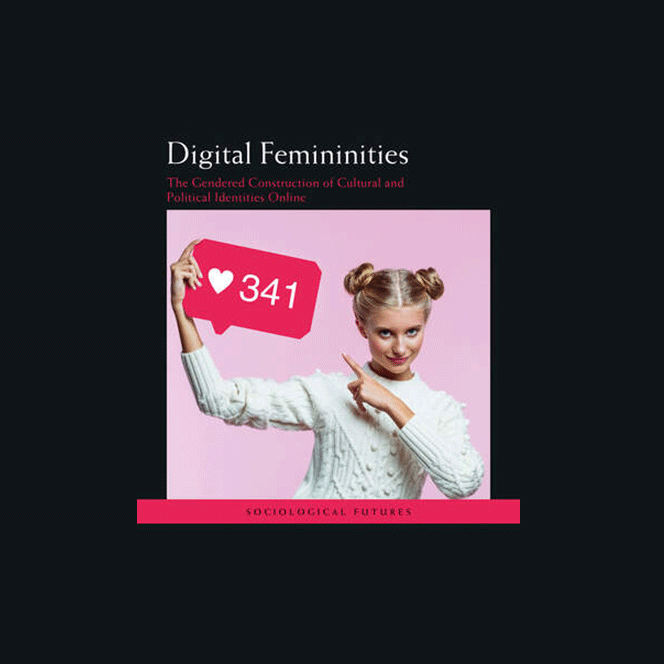What is the role of social media platforms such as Instagram in the construction and production of femininity in contemporary Britain? This was the driving question behind a research study I conducted, which has recently been published as a monograph in the BSA’s Sociological Futures series. This book, entitled Digital Femininities, explores this question through focus group research with girls and young women between the ages of 12 and 18. Against a backdrop of various news articles and public and political commentaries about the ‘dangers’ of social media for young people (and, specifically, young women), I set out to better understand how girls and young women narrate and explain their own relationship with social media platforms. I conducted nine focus groups with a total of 63 participants in three sites across England (the West Midlands, the South East and the North West). In these focus groups, participants shared their thoughts on a range of topics including influencers, filters and photo editing, celebrity culture, parental and peer surveillance, feminism, ‘fitspo’ and politics. Perhaps unsurprisingly, the conversations I had with participants resulted in some complex and often contradictory findings. While participants were often critical of ‘social media’ as a site of ‘fake’ femininity, unrelenting pressure and increasing commodification of the self, they also clearly understood various social media platforms as a key site of identity construction, relationship formation and, occasionally, politicisation. Digital Femininities explores the complexities and contradictions at the heart of these responses, and some of the key issues that emerged are briefly outlined below.
One of the overwhelming observations that I made during these discussions was the complex relationship that participants had with new notions of visibility and surveillance that were inextricably tied up with new notions of femininity and celebrity culture. Perhaps unsurprisingly, participants understood their digital lives as being primarily structured by visibility and surveillance. This (often quite benign) awareness of being highly visible and highly ‘watched’ meant that digital identity construction often needed to be carefully managed. In some cases, this meant that participants often sought out spaces that were more ‘anonymous’ (such as, at the time of my research, Tumblr) or spaces that parents had less knowledge of and were therefore less likely to monitor (such as Snapchat). As such, visibility and surveillance appeared to structure almost all aspects of social media use, even if it meant seeking out ways to minimise a seemingly relentless feeling of being ‘watched’.
Closely related to new forms of visibility and surveillance was participants’ assertions that ‘looking good’ was the primary characteristic that young women were encouraged to aspire to in digital contexts. ‘Looking good’ was closely tied to consumption – of clothes, of cosmetics or, as one year eight participant said, ‘of surgeries and things’. However, ‘looking good’ was also a highly regulated aspiration and could only be achieved through the production of a particular type of ‘natural’ femininity. During focus groups, participants were often keen to draw distinctions between themselves and ‘other’ girls and women. ‘Other’ women were often positioned as ‘fake’ and ‘attention-seeking’ due to posting ‘inappropriate’ selfies, editing their photos before posting them or trying ‘too hard’. However, it was also apparent that social media, selfies and the various beautification trends that went alongside them were also used in the attainment of participants’ own value and these complexities in relation to participants’ feelings about the ‘correct’ standards of femininity are explored in more detail in the book. Performances of femininity have long been measured against a classed construction of ‘respectability’ (Skeggs 1997) and the ways in which this emerged during focus groups demonstrated that ‘respectability’ remains central to the ways in which young women understand themselves and others in digital contexts.
While appearance and consumption have long been tied to dominant constructions of femininity, this has arguably intensified in the digital age. For example, a key cornerstone of social media is a heavily feminised ‘influencer culture’ that presents and promotes a lifestyle that much of its audience cannot afford to cultivate – a kind of cruel optimism (Berlant 2011) that obscures the precarity and economic insecurity that structures many young people’s (and, indeed, potentially many influencers’) lives. Although outside the scope of my original study, it is worth noting that these digital cultures that rest heavily on ‘authentic’ forms of advertising via influencer brand partnerships may also contribute to an increased rise in personal debt largely generated by the use of online ‘buy now, pay later’ (BNPL) mechanisms, such as Klarna and Clearpay. The use of these BNPL schemes is itself gendered, with reports suggesting that 75% of users are women, in part due to their ‘strong uptake in the online fashion sector’ (FCA 2021). The relationship between influencer culture and BNPL schemes is underexplored, but the dominance of influencer cultures in the cultural lives of many young women suggests that future research would benefit from an exploration of this relationship, especially as Britain enters a fast-exacerbating cost-of-living crisis that is expected to target young people in unprecedented ways (Chaddah 2022).
This ‘influencer’ lifestyle was regularly mentioned by participants in my study as a key basis for the construction of girls’ own identities. The hyper-visibility of a specific form of femininity via the cultivation of new ‘celebrity cultures’ on social media platforms such as Instagram intersected with participants’ understandings of their own sense of self. This was based on an increasing tendency for even ‘ordinary’ (i.e. non-celebrity) social media users to cultivate audiences through various strategies of self-branding and the ‘contentification’ of all aspects of their personal and intimate lives.
The promise of economic mobility and capital through the acquisition of a high number of followers simply by presenting a desirable self to a large enough audience was also noted by participants. Participants occasionally expressed ambivalence or outright concern about these new forms of labour, suggesting that they present a falsified version of an aspirational lifestyle that doesn’t really exist. However, there was also a simultaneous fascination with these new forms of celebrity that are seemingly ‘democratised’ and open to anyone who can obtain a sizeable audience. The tension between being both allured by and critical of these constructions of ‘the good life’ played out in interesting ways and seemed to be a key feature of attitudes towards and experiences of social media more broadly.
Building on the works of others who have explored constructions of girlhood and/or femininity in the twenty first century, such as Anita Harris, Rosalind Gill and Angela McRobbie, Digital Femininities explores the ways in which the ‘new femininities’ that emerged in the late twentieth and early twenty first centuries have been both maintained and transformed within a digital context and will be of interest to anyone who works on the topics of femininity, gender relations and digital platforms.
References
Berlant, L. (2011) Cruel Optimism, Durham, NC: Duke University Press
FCA (2021) ‘The Woolard Review: A review of change and innovation in the unsecured credit market’, FCA: London
Skeggs, B. (1997) Formations of Class and Gender: Becoming Respectable, London: Sage
Dr Frankie Rogan is a Lecturer in Sociology and the current Deputy Head of the Department of Social Policy, Sociology and Criminology at the University of Birmingham, UK, where she teaches on both undergraduate and postgraduate programmes. Her primary research interests include gender/feminist theory, cultural politics, new media and the impact of social and economic change on self-hood and identity.


